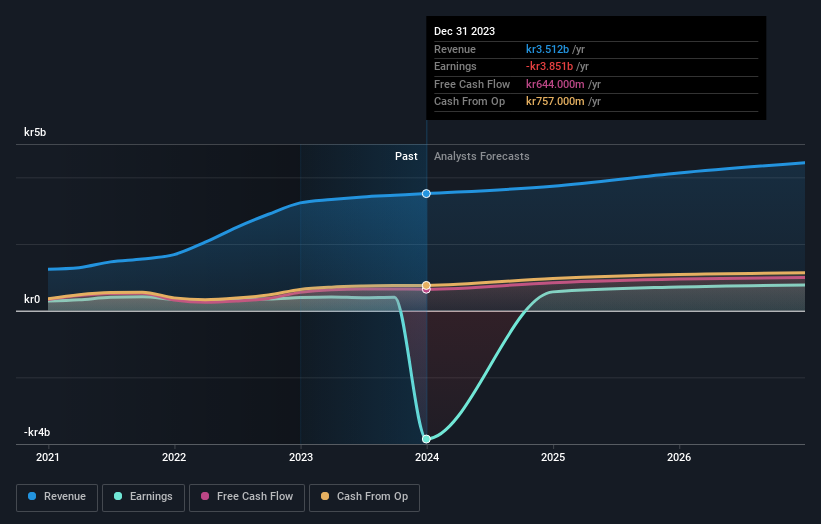Vitrolife AB (publ) Just Missed Earnings; Here's What Analysts Are Forecasting Now

The yearly results for Vitrolife AB (publ) (STO:VITR) were released last week, making it a good time to revisit its performance. Things were not great overall, with a surprise (statutory) loss of kr28.44 per share on revenues of kr3.5b, even though the analysts had been expecting a profit. Following the result, the analysts have updated their earnings model, and it would be good to know whether they think there's been a strong change in the company's prospects, or if it's business as usual. So we collected the latest post-earnings statutory consensus estimates to see what could be in store for next year.
Check out our latest analysis for Vitrolife

Taking into account the latest results, the current consensus from Vitrolife's four analysts is for revenues of kr3.73b in 2024. This would reflect a reasonable 6.3% increase on its revenue over the past 12 months. Earnings are expected to improve, with Vitrolife forecast to report a statutory profit of kr4.16 per share. Before this earnings report, the analysts had been forecasting revenues of kr3.77b and earnings per share (EPS) of kr4.40 in 2024. So it looks like there's been a small decline in overall sentiment after the recent results - there's been no major change to revenue estimates, but the analysts did make a minor downgrade to their earnings per share forecasts.
It might be a surprise to learn that the consensus price target was broadly unchanged at kr245, with the analysts clearly implying that the forecast decline in earnings is not expected to have much of an impact on valuation. That's not the only conclusion we can draw from this data however, as some investors also like to consider the spread in estimates when evaluating analyst price targets. There are some variant perceptions on Vitrolife, with the most bullish analyst valuing it at kr270 and the most bearish at kr230 per share. Even so, with a relatively close grouping of estimates, it looks like the analysts are quite confident in their valuations, suggesting Vitrolife is an easy business to forecast or the the analysts are all using similar assumptions.
One way to get more context on these forecasts is to look at how they compare to both past performance, and how other companies in the same industry are performing. We would highlight that Vitrolife's revenue growth is expected to slow, with the forecast 6.3% annualised growth rate until the end of 2024 being well below the historical 26% p.a. growth over the last five years. By way of comparison, the other companies in this industry with analyst coverage are forecast to grow their revenue at 18% per year. Factoring in the forecast slowdown in growth, it seems obvious that Vitrolife is also expected to grow slower than other industry participants.
The Bottom Line
The most important thing to take away is that the analysts downgraded their earnings per share estimates, showing that there has been a clear decline in sentiment following these results. Fortunately, the analysts also reconfirmed their revenue estimates, suggesting that it's tracking in line with expectations. Although our data does suggest that Vitrolife's revenue is expected to perform worse than the wider industry. The consensus price target held steady at kr245, with the latest estimates not enough to have an impact on their price targets.
With that in mind, we wouldn't be too quick to come to a conclusion on Vitrolife. Long-term earnings power is much more important than next year's profits. We have forecasts for Vitrolife going out to 2026, and you can see them free on our platform here.
You can also see whether Vitrolife is carrying too much debt, and whether its balance sheet is healthy, for free on our platform here.
New: Manage All Your Stock Portfolios in One Place
We've created the ultimate portfolio companion for stock investors, and it's free.
• Connect an unlimited number of Portfolios and see your total in one currency
• Be alerted to new Warning Signs or Risks via email or mobile
• Track the Fair Value of your stocks
Have feedback on this article? Concerned about the content? Get in touch with us directly. Alternatively, email editorial-team (at) simplywallst.com.
This article by Simply Wall St is general in nature. We provide commentary based on historical data and analyst forecasts only using an unbiased methodology and our articles are not intended to be financial advice. It does not constitute a recommendation to buy or sell any stock, and does not take account of your objectives, or your financial situation. We aim to bring you long-term focused analysis driven by fundamental data. Note that our analysis may not factor in the latest price-sensitive company announcements or qualitative material. Simply Wall St has no position in any stocks mentioned.
About OM:VITR
Vitrolife
Provides assisted reproduction products in Europe, the Middle East, Africa, Asia-Pacific, and the Americas.
Undervalued with adequate balance sheet.
Similar Companies
Market Insights
Community Narratives



